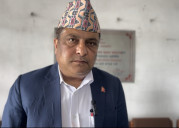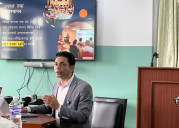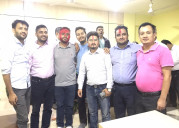EFFECT OF YOGA ON HYPERTENSION

 Hypertension is a clinical condition characterized by persistently elevated blood pressure. Every time the human heart beats, it pumps blood to the whole body through the arteries. Blood pressure is the force of blood pushing up against the blood vessel walls. The higher the pressure the harder the heart has to pump. The normal level for blood pressure is between 120/80 and above 139/89 is called pre hypertension and blood pressure of more than 140/90 is considered as hypertension (Schmieder, et al., 2012).
Hypertension is a clinical condition characterized by persistently elevated blood pressure. Every time the human heart beats, it pumps blood to the whole body through the arteries. Blood pressure is the force of blood pushing up against the blood vessel walls. The higher the pressure the harder the heart has to pump. The normal level for blood pressure is between 120/80 and above 139/89 is called pre hypertension and blood pressure of more than 140/90 is considered as hypertension (Schmieder, et al., 2012).
Hypertension is a major public health issue and affects approximately billion of people worldwide and is a major risk factor in the development of stroke, cardiovascular and chronic kidney disease (Murugesan, Govindarajulu, & Bera, 2000). Hypertension is a non-communicable disease having high prevalence and a concomitant increase in the risk of disease (Cohen & Townsend, 2007). This disease leads to cause of death for both men and women worldwide and also increase the risk of developing anxiety and depression.(Chaddha, 2015)
Hypertension is caused due to increase in a volume of blood as a result increase pressure on the lateral wall of the vessel. It is also defined as blood pressure which exceeds above 140mmhg over 90mmhg(Cohen & Townsend, 2007). Blood pressure has two terminologies; systolic pressure which means an output of blood from the heart when its contract and diastolic means when the heart is at rest. The normal value of systolic is 120mmhg and diastolic is 80mmHg (Brady, 2012). Blood pressure depends on the action. When a body is at rest at night, it falls down and when a body is at work or exceed to high. Hypertension is classified as primary hypertension and secondary hypertension. Primary hypertension is due to genetic factors and nonspecific lifestyle. Secondary hypertension defined as high blood pressure due to result of other disease cause such as chronic kidney disease, narrowing arteries of kidney and endocrine disorder.(Murugesan et al., 2000)
Causes of hypertension
The exact cause of hypertension is unknown but several factors effects on its development. But various risks factor are responsible for the causation of hypertension, stress is one of the main factor due to modern life style. Stress can be studied under both Psychological and physiological domains both of which are very tightly interlinked. Stresscan be characterized as a negative emotional experience accompanied by predictable biochemical, physiological, cognitive, and behavioral changes that are directed either towards altering the stressful event or accepting to its effect. The initial response of the body to stressful situations may be arousal, excessive reactivity, and enervation, leading to cumulative damage to the body system (Taylor, 2008). Continues exposure to stress can lead to physiological and psychological symptoms such as anxiety and depression (S, 2008).
.Other risk factor for hypertension are sedentary life style, smoking, overweight. Heredity is also one of the cause. If the parents or grandparents had high blood pressure, children have high risk to develop it. While , it is mainly a disease of adults, hypertension can occur in childhood as well. Though, hypertension has no sign and symptoms. Generally the following groups of people are more likely to develop hypertension.
- People who smoke
- Women who are pregnant
- Women who take birth control pills
- People over the age of 35
- People who are overweight or obese
- People who are not active
Sign and symptoms of hypertension
Usually, it is asymptomatic which means patients does not feel any discomfort. Although blood pressure is high, some people feel perfectly well. It is also called silent killer as it damages the heart silently. Most patients complain with symptoms like headache, dizziness, pain in the back of the head, vertigo. Continuous persistant of high blood pressure leads to the risk of cardio-vascular diseases. Hence it is necessary to control hypertension in order to prevent serious complication heart, brain, eyes and kidneys.
Yoga
The concepts of yoga therapy is a holistic approach to health management at physical, mental, emotional, and intellectual levels with techniques to improve mental equilibrium.(KAUTS, 2009) It is endowed with great power of healing and a very simple technique. Yoga therapy is a very scientific system and not expensive. It provides strengthen and increase the tone of weak muscles and help with conscious control over the automatic function of the body. It teaches the art of relaxation, relieving muscular and nervous tension and leads to on increased energy. (Bhobe, 2000)
The modern medicine reliefs temporarily with the use of drugs to treat disease of psychosomatic type like hypertension, diabetes, asthma. But the tecniques of yoga therapy deals not only with physical sheath. It also includes techniques to operate on different sheaths of our existence.(Woodyard, 2011) The large number of yoga practices available in the text of yoga are adopted to balance and harmonise the disturbance at each of the five kosas and tackle this types of complex psychosomatic ailment.(Mrpharms et al., 2013)
Yoga therapy is the approach which cure the disease applying the yogic method. It is a disease oriented and mostly cure the non-communicable disease rise of stress.(Ebnezar, Bali, Nagarathna, & Nagendra, 2011) It is the science of healing which shower cures and remedies for all types of illness, ailments, and disorder. Yoga therapist use yogasanas and pranayama to cure the disorder from the root level. Sometimes only yogasana can also use the physical body by maintain in an asana to cure the physical disorder. It includes standing, sitting, kneeling, lying, balancing, inverted positions, stretching, twisting, and contraction and relaxation of muscles , producing a steady posture at a given time.(Cohen & Townsend, 2007) And also some use only pranamaya to heal all the mental a problem which includes naddisudha, right nostril breathing, left nostril breathing, ujjai breathing, bhrastrika and bhramari(Malhotra et al., 2004). Yoga therapy treats from physical, mental and spiritual level from the welfare of human health. All the method are used in a special way so that the diseases are eradicated from root level and also provide prevention to re-cure in the future. Therapy is given at a slow pace with slow, smooth, steady coordinated movements with full control at every stage. A regular practices twice a day is essential to eradicate the disease. Therapy should give in a quiet, well-ventilated area with less distraction and free of dust and cold breeze (Curtis, Osadchuk, & Katz, 2011).
Yoga therapy has been considered to be beneficial in several medical conditions; the most commonly studied are coronary artery disease and asthma, osteoarthritis, rheumatoid arthritis, hypertension, diabetes mellitus, epilepsy and the psychological disorder(Agarwal, 2013). By nature of the yoga intervention, it is not possible to have blinded studies, and a placebo effect cannot be excluded. Objective physiologic changes noted through intervention cannot be ignored, however, Yoga practices are only an adjunct to medical treatment if disease has been established.(Manuscript, 2012)
Disease according to yoga
Yoga says imbalance start in the manomaya level. All the likes and dislikes have come to play at this level. These imbalances amplify themselves resulting in mental illness called ‘adhis’. At this stage there are no symptoms at the physical level prompted by the perpetual growth of desires, these mental diseases, concealed in us, begin to manifest themselves externally. Gradual they percolate to the physical frame. Preponderance of ajnana (ignorance about one’s real state of bliss) leads one to perform wrong actions as the eating of unwholesome food, living in unheathly dwellings, doing things at untimely hours, injuries inflicted, association with the wicked, evil thoughts, etc. these breed physical diseases called vyadhis or the secondary diseases.
The adhis (primary diseases) are two-fold- samanya (ordinary) and sara (the essential). The former includes the diseases incidental to the body while the latter the rebirth to which men are subject. The samanya are normally produced during the interactions with the world. These may be termed as psychosomatic ailments.
Prevention of hypertension through yoga
According to the yoga philosopy, as describe in tarttireyaupanisads,human body are made up of 5 bodies which are called kosas. They are aanamayakosa, pranamayakosa, manomayakosa, vijnanamayakosa and anandamayakosa.(Chaddha, 2015)
In this modern era, all non-communicable disease including hypertension is induced due to stress. Adhijavyadhi means stress born disease. The stress reaction causing autonomic and endocrine imbalance leading to disease in the gross body.(Ebnezar et al., 2011)
We are only concern to cure the physical body. Since the disease arise from the inner astral layer of our existence. So the yoga therapy that provides techniques for correcting the problem at both from the gross and subtle levels. Yoga practices help in bringing about balance at the level of the five kosas (pancakosas) so that complete health can be restored. Pancakosa was found to be the most holistic concept of human existence which is in no way contracting the modern science approach to the understanding of human body. It is more generalized, holistic and hence can contain in it the physical body (annamayakosa) the next three layers pranamaya, manomaya and vijnanamayakosas which are called the subtle bodies in the Vedanta and spiritual lore. The fifth kosa the anandamayakosa is the causal body from where all the other layers take birth. Thus we got a holistic and concrete perspective of human existence as the foundation for yoga therapy. (Ebnezar et al., 2011)
Yoga pacifies the sympathetic nervous system and slow down the heart and relax muscles and mind deeply. It is the holistic science which manage the hypertension from root level.(Chaddha, 2015)
AnnamayaKosa practices which include:
Diet: Simple vegetarian wholesome food that calms down the mind (Sattvic diet) is recommended as it helps to maintain internal harmony in the body as well as mind.
Asana: A stable and comfortable posture, which gives deep relaxation to internal organs by massaging them thoroughly; all organs of the body start functioning in a harmonious manner and the mind becomes tranquil; increases the physical stamina. Standing practices: Hastauthanasana, Twisting, Rotation of hip, Ardhacakrasana, Ardhakaticakrasana, Garudasana, Vrichya asana (tree postures)
Sitting practices: Gaumukh asana, Ustrasana, Ardamatyandra asana. Vakrasana
Supine practices: Savaasana, naukasana
Prone practices :Bhujangaasana, Salamba asana
- Kriya: activates and revitalizes the organs; tones up their functions; cleansing external impurities.
- The Pranayama Kosa practices which include:
Breathing exercises and cleansing breath: Increases awareness about breathing, clears the lungs, corrects breathing pattern, and increases lung capacity. It increases the efficiency of utilization of oxygen.
Pranayama: Pranayama is the breathing exercise which is equally beneficial. Conscious breathing quickly lowers blood pressure. Pranayama can practice in sitting position with adopting any mudra. The back and neck should be straight while practicing. It can be practice in lying down to encourages the breath to arise smoothly without any force. There should be no strain in body but it should be relaxed completely. Some of the breathing techniques are: Naddhisuddhi, Bramari, Right nostril breathing, Bastrika, Sectional breathing,Hand stretch out breathing, Tiger breathing , Sitali ,Sitkari(Manjunath & Telles, 2005).
- The ManomayaKosa practices which include:
Cyclic meditation: Practices with repeated stimulation and relaxation. Om meditation and mind sound resonance technique (MSRT) for creating awareness and slowing down the mind. Thought process is reduced which inturn calms down the mind.
Devotional sessions: For emotional culture through "Bhakti Yoga".
- The VijnanamayaKosa Practices which include:
Lectures and yogic counseling using yogic concepts of fearlessness for stress management. All the above practices are incorporated with the aim to help a person achieve the final state of self-knowledge.
- The AnandamayaKosa (Bliss):
It’s a state of blissful silence with awareness and freedom of choice where the mind is not troubled by any stressful thoughts and fears. (Cohen & Townsend, 2007)
Diet for hypertension
Diet therapy is an important factor in overall care of GI patients. Diet plays a vital role for the proper function of the cardiovascular. Food should be fresh. Sattwik vegetable food is preferable. All the green leafy vegetable which produce antioxidant are beneficial.
Eat more fruits, vegetables, and low-fat dairy foods.
Cut back on foods that are high in saturated fat, cholesterol, and Trans fats.
Eat more whole-grain foods, poultry, and nuts.
Limit sodium, sweets, sugary drinks, red meats.
Magnesium, potassium and fiber help to control the blood pressure (Verschuren, 2012)
Treatment of hypertension from sat karma
Satkarma is a very precise and systematic holistic science. The satkarma is briefly described in hatha yoga pradipika. The Sanskrit meaning of satkarma: sat is six and karma means actions. Satkarma consists of six internal purification techniquies. It helps to create harmonies in the body by balancing the two pranic flow ida and pigala. The six satkarma are as follows;
Neti
It is a process of purifying of the respiratory tract and the nasal cavity. It includes jalaneti and sutra neti
Dhauti
It is also called vamanadhouti which the cleansing process of the upper gastrointestinal tract.
Nauli
A method of massaging and strengthening the abdominal organs.
Trataka
It is the intense practice of gazing eyes at one point or spot to increase the power of concentration. It is an excellent exercise of the eyeball.
For hypertensive people, only neti and trataka is recommended. And it should be practice under the guidance of yoga experts (Prajapat, 2012).
Conclusion
Yoga is the holistic science which provides us many techniques to tone up our body internally and externally. Asana helps to strengthen our muscles and bones and pranayama which makes easy for pranic flow. The satkarma helps to cleanse our internal organ. Yoga provides positive energy in our human body. If practice regularly every morning medication is no needed in daily life.
REFERENCE
- Agarwal, S. K. (2013). S cience, 2(3), 1–4.
- Bhobe, S. (2000). Integrated approach to yoga. The Nursing Journal of India, 91, 33, 42.
- Brady, T. M. (2012). Hypertension. Pediatrics in Review / American Academy of Pediatrics, 33, 541–52. http://doi.org/10.1542/pir.33-12-541
- Chaddha, A. (2015). Slow breathing and cardiovascular disease. International Journal of Yoga. http://doi.org/10.4103/0973-6131.158484
- Cohen, D., & Townsend, R. (2007). Yoga and Hypertension. The Journal of Clinical Hypertension. http://doi.org/10.4172/2157-7595.1000144
- Curtis, K., Osadchuk, A., & Katz, J. (2011). An eight-week yoga intervention is associated with improvements in pain, psychological functioning and mindfulness, and changes in cortisol levels in women with fibromyalgia. Journal of Pain Research, 4, 189–201. http://doi.org/10.2147/JPR.S22761
- Ebnezar, J., Bali, Y., Nagarathna, R., & Nagendra, H. (2011). Effect of an integrated approach of yoga therapy on quality of life in osteoarthritis of the knee joint: A randomized control study. International Journal of Yoga. http://doi.org/10.4103/0973-6131.85486
- KAUTS, A. (2009). Effect of yoga on academic performance in relation to stress.
- Malhotra, V., Singh, S., Sharma, S., Madhu, S. V, Gupta, P., & Tandon, O. P. (2004). Effects of yoga asanas and pranayama in non-insulin dependent diabetes mellitus. Indian Journal of Traditional Knowledge, 3, 162–167. Retrieved from http://www.niscair.res.in/sciencecommunication/researchjournals/rejour/ijtk/Fulltextsearch/2004/April 2004/Effects of yoga asanas and pranayama in non-insulin dependent diabetes mellitus.htm
- Manjunath, N. K., & Telles, S. (2005). Influence of Yoga and Ayurveda on self-rated sleep in a geriatric population.The Indian journal of medical research (Vol. 121).
- Manuscript, A. (2012). NIH Public Access, 37(1), 33–46. http://doi.org/10.1016/j.rdc.2010.11.001.Yoga
- Mrpharms, M. S. M., Ba, J. S., Ba, J. M., Loadman, M. A., Frcpc, D. C. L., Feeny, D., … Feeny, D. (2013). orIgInAl ArtIcle An assessment of the effects of Iyengar yoga practice on the health-related quality of life of patients with chronic respiratory diseases : A pilot study, 20(2), 17–23.
- Murugesan, R., Govindarajulu, N., & Bera, T. K. (2000). Effect of selected yogic practices on the management of hypertension. Indian Journal of Physiology and Pharmacology, 44(2), 207–210.
- Prajapat, D. S. (2012). Integral Role of Yoga Therapy on Psycho - Physiological Facet (Anxiety - Forced Vital Capacity) of Bronchial Asthmatics Life. School of Yog and Health, 2(1), 33–45.
- Verschuren, W. M. M. (2012). Diet and cardiovascular disease. Current Cardiology Reports, 14(6), 701–708. http://doi.org/10.1007/s11886-012-0318-2
- Woodyard, C. (2011). Exploring the therapeutic effects of yoga and its ability to increase quality of life. International Journal of Yoga. http://doi.org/10.4103/0973-6131.85485
- Dr. Prakash Raj Regmi. (2013). Hand Book Lifestyle and Non-Communicable Diseases.
1 Comments
-
It is very useful article. We need a perfect instructor to do "Sat Karma"





















बासुदेव न्यौपाने हाम्रो डक्टरमा संवाददाता एवं डेस्क सम्पादकका रुपमा कार्यरत छन् ।
View Other Stories by Author >>